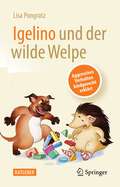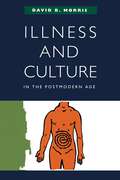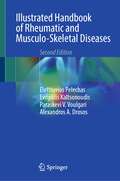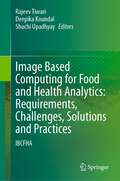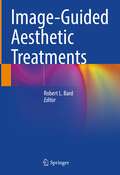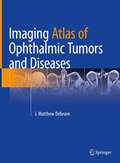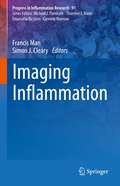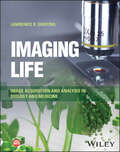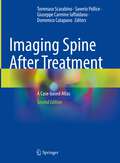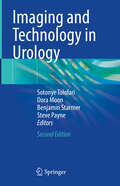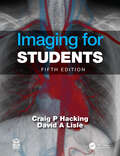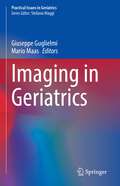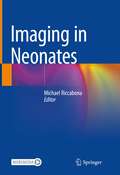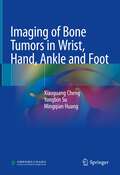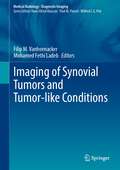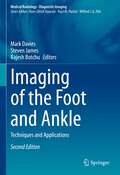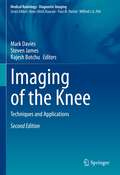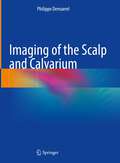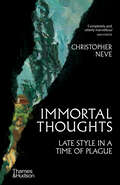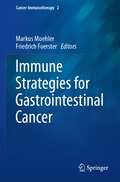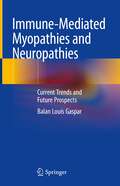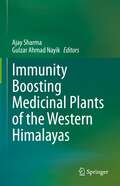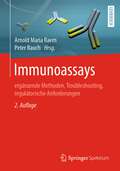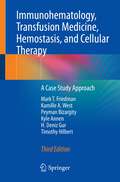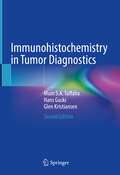- Table View
- List View
Igelino und der wilde Welpe: Aggressives Verhalten kindgerecht erklärt
by Lisa PongratzJedes Buch der Serie vom kleinen Igel Igelino thematisiert eine häufig vorkommende psychische Erkrankung im Kindes- und Jugendalter. Die Geschichten und Erklärungen sind auf kindgerechte, enttabuisierende Weise gestaltet und von einem jungen, künstlerischen Talent illustriert.Mit diesem Ratgeber erhalten Eltern und Angehörige die Möglichkeit, ihren noch jungen Kindern mit Hilfe der Geschichte von Igelino die menschliche Psyche im Falle aggressives Verhaltens (Störung des Sozialverhaltens, komplexe Traumatisierungen, Mobbing, Pubertät und Persönlichkeitsstörungen) altersgerecht verständlich zu machen. Hierbei liegt der Fokus jedoch nicht auf der eigenen Erkrankung bzw. den eigenen Symptomen, sondern auch in der Vermittlung von Wissen über psychische Störungen bei Familienmitgliedern, Freund*innen oder Klassenkamerad*innen mit Verhaltensauffälligkeiten.Eltern erhalten darüber hinaus wichtige grundlegende Informationen zur psychischen Störung, Tipps, wie eine solche Störung erkannt (und von anderen Verhaltensauffälligkeiten abgegrenzt) werden kann, wie man sich gegenüber Betroffenen verhält, sowie Informationen über Therapiemöglichkeiten, Anlaufstellen für Hilfsangebote und eigenständig durchführbare Interventionen in Form von Ressourcenübungen.1. Psychische Störungen: Zahlen und Fakten.- 2. Tipps zum gemeinsamen Lesen.- 3. Igelino und der wilde Welpe.- 4. Was ist aggressives Verhalten?- 5. Wie entsteht aggressives Verhalten?- 6. Wer kann helfen?- 7. Was können wir tun?
Illness and Culture in the Postmodern Age
by David B. MorrisWe become ill in ways our parents and grandparents did not, with diseases unheard of and treatments undreamed of by them. Illness has changed in the postmodern era—roughly the period since World War II—as dramatically as technology, transportation, and the texture of everyday life. Exploring these changes, David B. Morris tells the fascinating story, or stories, of what goes into making the postmodern experience of illness different, perhaps unique. Even as he decries the overuse and misuse of the term "postmodern," Morris shows how brightly ideas of illness, health, and postmodernism illuminate one another in late-twentieth-century culture.Modern medicine traditionally separates disease—an objectively verified disorder—from illness—a patient's subjective experience. Postmodern medicine, Morris says, can make no such clean distinction; instead, it demands a biocultural model, situating illness at the crossroads of biology and culture. Maladies such as chronic fatigue syndrome and post-traumatic stress disorder signal our awareness that there are biocultural ways of being sick.The biocultural vision of illness not only blurs old boundaries but also offers a new and infinitely promising arena for investigating both biology and culture. In many ways Illness and Culture in the Postmodern Age leads us to understand our experience of the world differently.
Illustrated Handbook of Rheumatic and Musculo-Skeletal Diseases
by Eleftherios Pelechas Evripidis Kaltsonoudis Paraskevi V. Voulgari Alexandros A. DrososThis book comprehensively reviews clinical aspects and features of rheumatic and musculo-skeletal diseases in an integrated and easy to read format. It enables the reader to become confident in identifying common and unusual disease symptoms and be able to apply a variety of diagnostic modalities and evaluate potential treatment options. Every disease covered has a variety of clinically relevant images detailing both typical and rare signs and symptoms. Each image is accompanied by a detailed description covering relevant epidemiological data, diagnostic modalities and treatment options. The Illustrated Handbook of Rheumatic and Musculo-Skeletal Diseases, 2ndEdition has been fully revised with new content and clinical photographs throughout each chapter. Rheumatologists seeking a comprehensive and clinically relevant guide for the diagnosis and treatment of a broad range of rheumatic and allied diseases will find this book to be an essential resource in their daily clinical practice.
Image Based Computing for Food and Health Analytics: IBCFHA
by Rajeev Tiwari Deepika Koundal Shuchi UpadhyayIncrease in consumer awareness of nutritional habits has placed automatic food analysis in the spotlight in recent years. However, food-logging is cumbersome and requires sufficient knowledge of the food item consumed. Additionally, keeping track of every meal can become a tedious task. Accurately documenting dietary caloric intake is crucial to manage weight loss, but also presents challenges because most of the current methods for dietary assessment must rely on memory to recall foods eaten. Food understanding from digital media has become a challenge with important applications in many different domains. Substantial research has demonstrated that digital imaging accurately estimates dietary intake in many environments and it has many advantages over other methods. However, how to derive the food information effectively and efficiently remains a challenging and open research problem. The provided recommendations could be based on calorie counting, healthy food and specific nutritional composition. In addition, if we also consider a system able to log the food consumed by every individual along time, it could provide health-related recommendations in the long-term. Computer Vision specialists have developed new methods for automatic food intake monitoring and food logging. Fourth Industrial Revolution [4.0 IR] technologies such as deep learning and computer vision robotics are key for sustainable food understanding. The need for AI based technologies that allow tracking of physical activities and nutrition habits are rapidly increasing and automatic analysis of food images plays an important role. Computer vision and image processing offers truly impressive advances to various applications like food analytics and healthcare analytics and can aid patients in keeping track of their calorie count easily by automating the calorie counting process. It can inform the user about the number of calories, proteins, carbohydrates, and other nutrients provided by each meal. The information is provided in real-time and thus proves to be an efficient method of nutrition tracking and can be shared with the dietician over the internet, reducing healthcare costs. This is possible by a system made up of, IoT sensors, Cloud-Fog based servers and mobile applications. These systems can generate data or images which can be analyzed using machine learning algorithms. Image Based Computing for Food and Health Analytics covers the current status of food image analysis and presents computer vision and image processing based solutions to enhance and improve the accuracy of current measurements of dietary intake. Many solutions are presented to improve the accuracy of assessment by analyzing health images, data and food industry based images captured by mobile devices. Key technique innovations based on Artificial Intelligence and deep learning-based food image recognition algorithms are also discussed. This book examines the usage of 4.0 industrial revolution technologies such as computer vision and artificial intelligence in the field of healthcare and food industry, providing a comprehensive understanding of computer vision and intelligence methodologies which tackles the main challenges of food and health processing. Additionally, the text focuses on the employing sustainable 4 IR technologies through which consumers can attain the necessary diet and nutrients and can actively monitor their health. In focusing specifically on the food industry and healthcare analytics, it serves as a single source for multidisciplinary information involving AI and vision techniques in the food and health sector. Current advances such as Industry 4.0 and Fog-Cloud based solutions are covered in full, offering readers a fully rounded view of these rapidly advancing health and food analysis systems.
Image-Guided Aesthetic Treatments
by Robert L. BardThis book offers a detailed and up-to-date overview of image-guided aesthetic treatments. A wide range of aesthetic image-guided procedures in different body regions are described in more than twenty chapters. For each procedure, the benefits of image guidance are identified and its use is clearly explained. The coverage includes all the major tools commonly employed by today’s aesthetic and plastic surgeons, such as spectral imaging, laser, microfocused ultrasound, and radiofrequency technologies. Image guidance of aesthetic treatments has a variety of benefits: Image-guided treatment by means of non-surgical or minimally invasive modalities greatly reduces patient anxiety and the likelihood of postoperative disfigurement. Image guidance allows the physician to measure the skin thickness and the depth of fat tissue and to evaluate the elasticity of the skin and subcutaneous tissues, improving thermal treatment outcomes. It can also map the arteries, veins, and nerves, thereby providing preoperative landmarks and permitting reduction of postoperative bleeding and avoidance of nerve damage. Furthermore, imaging can non-invasively identify subdermal fillers or implants, assisting in the identification of migration with attendant vascular compromise or nerve entrapment. Image-Guided Aesthetic Treatments will be a valuable guide and reference not only for aesthetic practitioners, plastic surgeons, and other specialists, but also for imaging technicians and interested laypersons.
Imaging Atlas of Ophthalmic Tumors and Diseases
by J. Matthew DebnamThis atlas describes an array of tumors and diseases that affect the orbit and associated cranial nerves. Often lacking in radiology residency and fellowship training is teaching of the anatomy of the orbit and cranial nerves, as well as the imaging appearance of orbital tumors and diseases that affect these regions. This atlas fills this gap of knowledge with tumors and diseases encountered and treated at MD Anderson Cancer Center, providing a review of the imaging anatomy and the appearance of the tumors and diseases that should aid in formatting a differential diagnosis. The text consists of ten chapters divided into separate anatomic sections followed by an eleventh chapter describing the treated orbit and tumor recurrence. Each of the first ten chapters begins with a description of the relevant anatomy, labeled CT and MRI images and drawings to highlight important anatomic considerations. This is an ideal guide for practicing general radiologists, neuroradiologists and trainees, as well as ophthalmologists, head and neck surgeons, neurosurgeons, medical and radiation oncologists, and pathologists who interpret or review orbital images as part of their daily practice.
Imaging Inflammation (Progress in Inflammation Research #91)
by Francis Man Simon J. ClearyImaging Inflammation provides updates on cutting-edge imaging methods being applied to problems in inflammation research. From state-of-the-art research tools to diagnostic tests, and from single-cell to whole-body imaging, this volume offers a comprehensive overview of how imaging experts across a range of disciplines are expanding our understanding of inflammation and immunity.
Imaging Life: Image Acquisition and Analysis in Biology and Medicine
by Lawrence R. GriffingHands-on resource to understand and successfully process biological image data In Imaging Life: Image Acquisition and Analysis in Biology and Medicine, distinguished biologist Dr. Lawrence R. Griffing delivers a comprehensive and accessible exploration of scientific imaging, including but not limited to the different scientific imaging technologies, image processing, and analysis. The author discusses technical features, challenges, and solutions of the various imaging modalities to obtain the best possible image. Divided into three sections, the book opens with the basics such as the various image media, their representation and evaluation. It explains in exceptional detail pre- and postprocessing of an image. The last section concludes with common microscopic and biomedical imaging modalities in light of technical limitations and solutions to achieve the best possible image acquisition of the specimen. Imaging Life: Image Acquisition and Analysis in Biology and Medicine is written specifically for readers with limited mathematical and programming backgrounds and includes tutorials on image processing in relevant chapters. It also contains exercises in the use of popular, open-source software. A thorough introduction to imaging methods, technical features, challenges, and solutions to successfully capture biological images Offers tutorials on image processing using open-source software in relevant chapter Discusses details of acquisition needs and image media covering pixels, pixel values, contrast, tonal range, and image formats In-depth presentation of microscopic and biomedical imaging modalities Perfect for professionals and students in the biological sciences and engineering, Imaging Life: Image Acquisition and Analysis in Biology and Medicine is an ideal resource for research labs, biotech companies, and equipment vendors.
Imaging Spine After Treatment: A Case-based Atlas
by Tommaso Scarabino Saverio Pollice Giuseppe Carmine Iaffaldano Domenico CatapanoThis atlas illustrates the characteristics of imaging after surgical spine treatment. The previous edition has been thoroughly updated and new surgical treatment options are presented. Furthermore, all clinical cases feature new images with the new sequences available from the manufacturers of Magnetic Resonance scanners. The imaging methods presented in the book are MRI, involving the use of routine basic sequences and advanced study techniques, and CT with and without administration of contrast medium. The modifications of the spine, both healthy and pathological, that can occur immediately after surgical treatment and in the long term, are described in detail. Atlas contents are organized in a general part, with the classification of spine pathology and the surgical treatment options, and a part with clinical cases enriched by a wealth of images. This easy-to-consult publication addresses neuroradiologists who wish to gain an adequate expertise in post-treatment examinations reporting in order to be able to perform an effective differential diagnosis.
Imaging and Technology in Urology
by Steve Payne Sotonye Tolofari Dora Moon Benjamin StarmerThis book offers a new edition of the hugely successful title, Imaging & Technology in Urology--Principles and Clinical Applications edited by Steve Payne, Ian Eardley, Kieran O'Flynn in 2012. Essential reading for preparation of exit exams in Urology, it is used worldwide by exam candidates. Fully updated in essential areas of the book following on from recent developments in the last decade, it helps give preparation to candidates. The most comprehensive and reliable source of information on this particular topic.
Imaging for Students
by David Lisle Craig Hacking'I would have found this book invaluable at medical school, but as a now qualified GP I think it is a fabulous resource. The fact it covers so much is remarkable … It is so comprehensive – great images, well explained.' Donna Pilkington, GP with an interest in medical education, Northern Ireland, UK 'It is direct and succinct. Just what you need in a portable book that aims to give you the essentials [it does] a great job of incorporating a huge amount of information covering the wide range of radiology examinations and procedures into a readable and practical book for students. A good introduction for year 1 radiology residents too.' Dr Mike Hurrell, Clinical Senior Lecturer and Consultant Radiologist, University of Otago, Christchurch, New Zealand 'The text works very well for the Medical Imaging Students – providing an overview of each modality and key insights into the clinical question to be resolved … the information is presented in an accessible fashion and well-illustrated.' Associate Professor Debbie Starkey, Discipline Leader, Medical Radiation Sciences, School of Clinical Sciences, Faculty of Health, Queensland University of Technology, Brisbane, Australia Imaging for Students delivers step-by-step guidance to the range of imaging techniques available, providing a clear explanation of how each imaging modality actually works, and including information on the associated risks and hazards. Throughout, the importance of patient preparation and post-procedure observation is emphasized. Taking information from evidence-based studies and published guidelines, in line with current clinical practice, the book takes a highly logical approach to the investigation of clinical scenarios, where possible indicating the 'best first test'—vital to both appropriate clinical and cost-effective decision-making. Key Features: Readable and concise – focusing on the common diseases that medical students most frequently encounterFully revised and updated – including up-to-date information on the latest imaging techniques including spectral CT, liver elastography, new and emerging PET techniques, multiparametric imaging and the role of AIHeavily illustrated - over 450 high-quality photographs, many new to this edition including colour images, are essential to support this visual subjectHighly structured and accessible format – plentiful use of tables and lists, and introduction of new summary boxes, all ideal for study and exam preparationCompanion website – image library including normal anatomy, clinical cases and MCQs for self-assessment, RADS reporting systems and detailed staging systems for common tumours relevant to each section; visit www.routledge.com/cw/hacking Drawing on the extensive clinical and teaching experience of its respected author team, the fifth edition of Imaging for Students gives students and junior doctors everything they need to understand the advantages, disadvantages, and possible side effects of the imaging modalities available, and how to apply them appropriately in clinical practice. The Authors: Craig Hacking is an Associate Professor of Radiology and Academic Lead for Clinical Radiology, University of Queensland Medical School and a Consultant Radiologist and the Medical Director of Medical Imaging at the Royal Brisbane and Women’s Hospital, Brisbane, Australia. David Lisle is an Associate Professor of Medical Imaging, University of Queensland Medical School, a Consultant Radiologist at Brisbane Private Hospital, Brisbane, Australia, an examiner for the Royal Australian and New Zealand College of Radiologists and is the author of previous editions of Imaging for Students. </
Imaging in Geriatrics (Practical Issues in Geriatrics)
by Giuseppe Guglielmi Mario MaasThis book addresses in a structured and multidisciplinary way the medical issues related to aging, paying particular attention to the role of diagnostic imaging in the field of cardiovascular, musculoskeletal, respiratory, neurological, urogenital and gastrointestinal diseases.The progressive increase of the average age of the population, of life expectancy and the improvement of the quality of life are common phenomena in many countries of the World. Over the years, the management of older persons seems to have had an increasing impact both on the socio-economic and on the medical-health level. Medicine, in all its branches, has in fact focused more and more on the health conditions of the elderly patient and its protection and, in this context, due to the increasing progress in the field of technology and imaging methods, the radiologist occupies a front-line position. Unlike the young or middle-aged patients, the elderly need special care and attention, especially because of the involutive-degenerative senile processes they have to face, which must be taken into account to avoid incurring into misdiagnosis. Radiology, in fact, aims more and more at developing imaging techniques that are on the one hand satisfactory and comprehensive, but at the same time that do not represent any risk and/or obstacle for the elderly patient. The aim of this book is to provide the radiologist, and not only, with an adequate and complete geriatric preparation, thus to improve the diagnostic-therapeutic management of those patients who, to date, constitute the most conspicuous part of the medical-health users.
Imaging in Neonates
by Michael RiccabonaThis book provides a concise overview of neonatal imaging. After a short clinical introduction on the crucial role of imaging in diagnosing and treating neonatal conditions, it discusses the various methods (ultrasound, digital radiography, fluoroscopy, CT, and MRI) available and explains in detail how they have to be adapted for neonatal applications. Chapters feature imaging findings and differential diagnoses for the most common neonatal conditions. Additionally, some relevant aspects of foetal imaging are presented. Written by an interdisciplinary team, Imaging in Neonates is a practical resource for daily use in the ward for all medical professionals involved in treating neonates.
Imaging of Bone Tumors in Wrist, Hand, Ankle and Foot
by Xiaoguang Cheng Yongbin Su Mingqian HuangThis book provides a detailed description of typical imaging features of bone tumors and tumor-like lesions in the wrist, hand, ankle and foot. Each chapter deals with one major bone tumor or tumor-like lesions, for example, chondroma, enchondroma, gout, giant cell tumors, lymphoma, osteosarcoma, bone metastases, etc. Typical cases are carefully selected from thousands of clinical cases accompanying with comprehensive imaging information of X-ray, CT and MRI. In-depth analysis and differential diagnostic tips from experienced bone tumour specialists is presented at the end of each chapter. This book will be useful and worthy to musculoskeletal radiologists, orthopaedic surgeons, general radiologists, and oncologists.
Imaging of Synovial Tumors and Tumor-like Conditions (Medical Radiology)
by Filip M. Vanhoenacker Mohamed Fethi LadebThis vastly illustrated book offers a comprehensive survey of the role of imaging in the diagnosis of synovial tumors and tumor-like conditions. It gives an overview of the anatomy and histology of the synovium and discusses the classification, pathology, genetics and molecular biology of synovial tumors. The book presents the benefits of various imaging modalities in the diagnosis of these masses, which is important to provide appropriate treatment.Imaging of Synovial Tumors and Tumor-like Conditions will be a valuable resource not only for radiologists but also for orthopedic surgeons, oncologists, radiotherapists, and pathologists.
Imaging of the Foot and Ankle: Techniques and Applications (Medical Radiology)
by Steven James Mark Davies Rajesh BotchuUp-to-date and comprehensive textbook on imaging of the foot and ankle. In the first part, the various techniques and procedures are discussed in detail. Individual chapters are devoted to: radiography, arthrography and tenography, computed tomography and CT arthrography, magnetic resonance imaging and MR arthrography, ultrasonography, and intra-articular injections. The second part documents the application of these techniques to diverse clinical problems and diseases, including: congenital and developmental disorders, trauma, tendon and ligament pathology, compressive neuropathies, infection, and the diabetic foot. Each chapter is written by an acknowledged expert, and a wealth of illustrative material is included.
Imaging of the Knee: Techniques and Applications (Medical Radiology)
by Steven James Mark Davies Rajesh BotchuAn up-to-date and comprehensive review of the discipline of imaging of the knee. The first part discusses the various techniques employed when imaging the knee. Individual chapters are devoted to radiography, arthrography, computed tomography and CT arthrography, magnetic resonance imaging and MR arthrography, and ultrasonography. The second part then documents the application of these techniques to the diverse clinical problems and diseases encountered in the knee. Among the many topics addressed are: congenital and developmental abnormalities, trauma, meniscal pathology, and others. Each chapter is written by an acknowledged expert in the field.
Imaging of the Scalp and Calvarium
by Philippe DemaerelThis richly illustrated book provides a comprehensive account of the imaging of scalp and calvarial lesions. It discusses essential facts such as the anatomy and pathology of the scalp and calvarium, imaging findings in CT and MRI, differential diagnosis, and selected references. The author presents the key information on the left and illustrations on the right side of the book. While the book shows the most common radiological examples, it also includes less typical cases.The uniform design and easy-to-use structure make the book a valuable reference guide for (neuro)radiology, neurosurgery, and dermatology specialists.
Immortal Thoughts: Late Style In A Time Of Plague
by Christopher NeveA remarkable, heartfelt, beautifully written analysis of the late work of major artists which author Max Porter has called “completely and utterly marvelous.” In 2020, as the spread of COVID-19 caused pandemonium worldwide,a painter and writer returned to a childhood home to reflect upon the transcendence of nature and the work of the artists he most admires. It seems to Christopher Neve that in their final works—their late style—that they have something remarkable in common. This has more to do with intuition and memory than with rationality or reason. Immortal Thoughts: Late Style in a Time of Plague is an anthology of these reflections. In this personal and moving account, nineteen short essays on artists are interspersed with recollections of the cataclysmic global progress of the disease in poignant contrast to the beauty of the seasons in Neve’s isolated house and garden. From Paul Cézanne and Michelangelo to Rembrandt and Gwen John, Neve dwells on artists’ late ideas, memories, risks, and places in the context of time and mortality. As much art history as a discussion of great art in the context of the “dance of death,” Neve also writes about Pierre Bonnard, Giorgio Morandi, Nicolas Poussin, Chaim Soutine, and many others. Immortal Thoughts is a summary of a lifetime’s contemplation of art.
Immune Strategies for Gastrointestinal Cancer (Cancer Immunotherapy #2)
by Markus Moehler Friedrich FoersterThis book provides an overview of the available evidence surrounding immunotherapy in gastrointestinal cancers, and discusses its future place in clinical practice.Immunotherapy has celebrated some astonishing therapeutic successes in a variety of cancer types and is becoming increasingly relevant in daily clinical practice. Currently, the predominant class of immunotherapeutic drugs is the so-called checkpoint inhibitors, which disengage the physiological brakes on the immune system, enabling a more effective anti-cancer immune response. Malignancies of the gastrointestinal tract, which account for the majority of cancer cases worldwide, are a major cause of morbidity and mortality, creating an urgent need for more effective therapies. A large number of clinical trials have evaluated the efficacy of cancer immunotherapy in gastrointestinal malignancies and demonstrated its potential in certain subsets of patients. This book will appeal to a wide readership, including oncologists, health care professionals in general and biomedical scientists.
Immune-Mediated Myopathies and Neuropathies: Current Trends and Future Prospects
by Balan Louis GasparThe book covers all aspects of immune-mediated diseases of the muscle and nerve, which are a group of complex diseases, whose diagnosis needs a team of specialists in the field of neuropathology, immunopathology, neurology, and rheumatology. Nerve and muscle biopsy evaluation is invaluable in distinguishing immune-mediated from etiologies and therefore, despite being invasive, pathological evaluation of nerve and muscle has stood the test of time. Chapters cover all the essential aspects of each disease entity viz. the pathogenesis, clinical features, diagnostic armamentarium, and guidelines for diagnosis and management. It is supplemented with full-colorful illustrations and photomicrographs for better comprehension. It includes a chapter highlighting the current progress in the field of immune-mediated myopathies and neuropathies as it is a rapidly evolving field with the addition of many new entities.This clinically oriented book serves as a primer for general histopathologists as well as a practice guide for neuropathologists. It is also relevant for neurologists and rheumatologists and encourages young medical students, residents, and research scholars in the field of neuropathology, neurology, and rheumatology to get involved in active research.
Immunity Boosting Medicinal Plants of the Western Himalayas
by Ajay Sharma Gulzar Ahmad NayikThis book presents a comprehensive guide to traditional immunity-boosting medicinal plants of the Himalayas, their traditional uses, phytochemistry, pharmacology, diversity, conversation, biotechnology, toxicology, as well as future prospective. All the chapters cover the latest advances in ethnobotany, phytochemistry, biochemistry, and biotechnology. The book offers a valuable asset for researchers and graduate students of chemistry, botany, biotechnology, microbiology, and the pharmaceutical sciences. The main purpose of the present book is to draw on the rich culture, folklore, and biodiversity of immunity-boosting medicinal plants of the Western Himalayas, with particular emphasis on the Indian Trans-Himalayan and Western Himalayan region. All the plants included in the present book are extensively used by the local tribes and people for their health-promoting properties from ancient times. This book will be a substantial contribution to the knowledge of the region and the country. Also, the book will be very useful to scientists, graduates, and undergraduates, along with researchers in the fields of natural products, herbal medicines, ethnobotany, pharmacology, chemistry, and biology. Further, it is an equally significant resource for a person working in different traditional medicinal systems; doctors (especially those engaged in Ayurveda, Chinese traditional medicinal system, Amchi, and allopathy); the pharmaceutical industry (for drug design and synthesis); biochemistry and biotechnology sciences; and the agricultural sciences.
Immunoassays: ergänzende Methoden, Troubleshooting, regulatorische Anforderungen
by Arnold Maria Raem Peter RauchDieses Methodenbuch vermittelt eine gut lesbare, fundierte Einführung in die Grundprinzipien immunologischer Methoden. Wissenschaftler*innen der Naturwissenschaften und Medizin wie auch TAs können sich einen ersten, grundlegenden Einblick in die Durchführung der verschiedenen Immunoassays verschaffen und werden dabei über deren unterschiedliche Einsatzbereiche informiert. Jedes Kapitel in Immunoassays beginnt mit einer grundlegenden Einführung in die Thematik, bevor auch für den Laboralltag und die berufliche Praxis wichtige Details abgehandelt werden. Die Leser*innen erlangen mit dieser Lektüre Sicherheit beim Einsatz der Methoden im Laboralltag, da auftretende Probleme und was man dagegen tun kann im Detail besprochen werden. Hierbei sind die zahlreichen Tipps aus der Praxis sehr wertvoll. Besonders hervorzuheben in diesem Buch sind die akkuraten und funktionierenden Rezepte. Durch ihre tagtägliche Arbeit mit Immunoassays verfügen die Autoren wie auch die Herausgeber über einen reichen Erfahrungsschatz mit diesen Methoden. Eine rundum hilfreiche Lektüre für Einsteiger und erfahrene Praktiker.
Immunohematology, Transfusion Medicine, Hemostasis, and Cellular Therapy: A Case Study Approach
by Mark T. Friedman Kamille A. West Peyman Bizargity Kyle Annen H. Deniz Gur Timothy HilbertThe latest edition of this volume features an extensively revised and expanded collection of immunohematology and transfusion medicine case studies, comprised of clinical vignettes and antibody panels with questions following each case. Arranged in a workbook format, the text presents cases based on real patient problems and covers a number of common issues and challenging problems in blood banking and transfusion practice. Discussion and resolution of each case is provided in a separate answer section, including up-to-date information on pertinent advances in the field. This third edition updates information on existing case chapters and references and adds a variety of new case chapters. The enhanced title of this edition reflects upon the wider array of covered topics, including in-depth case studies of hemostasis and a second section with blood donation and cellular therapy topics. New features include a key to covered topics for each case and a case-difficulty rating scale. Written by experts in the field, Immunohematology, Transfusion Medicine, Hemostasis, and Cellular Therapy: A Case Study Approach, Third Edition is an interactive tool that makes blood banking and transfusion medicine memorable, practical, and relevant to residents, fellows, laboratory technologists, and anyone interested in gaining and updating their knowledge in the field
Immunohistochemistry in Tumor Diagnostics
by Hans Guski Glen Kristiansen Muin S.A. TuffahaThis new and updated edition provides an extensive overview of the antibodies employed in diagnostic tumor histopathology, and it presents concise summaries of the immunoprofiles of most tumors. Additionally, it offers practical diagnostic algorithms and invaluable tips to facilitate the interpretation of results.The work includes the newest available antibodies and the most recent 5th edition of the WHO classification of tumors. Furthermore, a chapter on biomarkers for theranostic applications has been added to enhance the book's utility. Designed as a practical and user-friendly bench reference for diagnostic tumor histopathology, this book is recommended to histopathologists of all levels, from aspiring residents to seasoned specialists seeking a reliable and comprehensive resource for tumor diagnostics. Moreover, it is highly recommended for oncologists, hematologists, and researchers involved in these fields.
